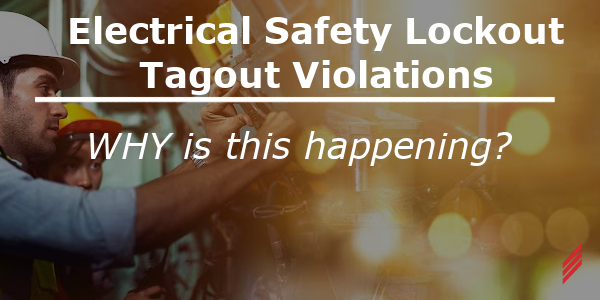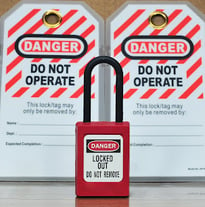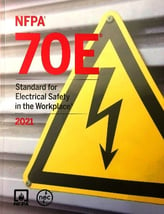Electrical Safety Lockout Tagout Violations – WHY is this Happening?
by Ralph Parrett on Feb 13, 2025 10:32:00 AM

OSHA has been releasing violations for 2022; and yet again, Lock-Out/Tag-Out is in the top 10 with 1,977 reported violations.1

Starting as a maintenance person, moving into the role of instructor and ultimately ending up where I am now as the Director of Electrical Safety Services, over the last 15 years I’ve honestly had the privilege of gaining a deep understanding of a variety of facilities including manufacturing, healthcare, education and power distribution. The one thing that blows my mind is how Lock-Out/Tag-Out remains in the top 10 year to year. WHY could very well be broken into opinion versus statistics resulting in fingers pointing back and forth trying to figure out WHO is to blame; resulting in no progression on HOW do we fix this? The goal of this blog series is to discuss these three questions, why, who, and how.
While we discuss the WHY in this part of the series, we will also be looking at the legal requirements put into place by the Occupational Safety and Health Administration (OSHA) and the Standard for Electrical Safety in the Workplace (NFPA 70E) from the National Fire Protection Agency (NFPA) to identify where we could be missing the mark.
Everything LOTO starts out in OSHA 29 CFR 1910.147 where OSHA lays out the blatant requirement found at 1910.147(a))3)(i) for employers to establish and maintain a means to disable machines when employees will be exposed to hazards that if they are exposed to could cause injury or death. For me though, OSHA does say it best here:
“Energy control program. The employer shall establish a program consisting of energy control procedures, employee training and periodic inspections to ensure that before any employee performs any servicing or maintenance on a machine or equipment where the unexpected energizing, start up or release of stored energy could occur and cause injury, the machine or equipment shall be isolated from the energy source, and rendered inoperative.” 1910.147(c)(1)
OSHA also states the following for electrical hazards:
“Exposure to electrical hazards from work on, near, or with conductors or equipment in electric-utilization installations, which is covered by subpart S of this par.” 1910.147(a)(1)(ii)(D)
For now, this leads us to the point where we can start diving into the WHY. This is one of my favorite questions to ask attendants in training sessions with me, “Why do you think this is still a problem?” and the responses I have gotten have always been consistent; here they are:
- Seeing LOTO as a pain instead of a protective measure
- Unaware of the hazard(s) present
- Being told to ignore the requirement and just get the job done
- Not having a full understanding of what could happen if LOTO is not performed
- It’s the way it’s always been done
- I can get the job done in half the time it would take me to perform LOTO
 The above, in my opinion, can be summarized into one word…..complacency. We as humans are not perfect and are fallible. Complacency is such a key driver to the root cause of these incidents happening that Informative Annex Q in the NFPA 70E has been solely dedicated to our performance in the workplace regarding Electrical Safety. If you haven’t, I highly encourage you to read through the first two pages paying particular attention to Q.4 where it discusses the different modes we can operate within and how they can lead to incidents.2 Another known “assignment” I have given was to reflect on the modes and to identify an incident you have been exposed to over your career and identify which mode(s) were being operated in. Normally, we can find the WHY just by reflecting the incident and seeing which mode(s) contributed to it. Within Annex Q, the NFPA 70E references Rasmussen’s Model that classifies human error driven by any one or combination of the following modes: rule-based, skill-based, and knowledge-based.3
The above, in my opinion, can be summarized into one word…..complacency. We as humans are not perfect and are fallible. Complacency is such a key driver to the root cause of these incidents happening that Informative Annex Q in the NFPA 70E has been solely dedicated to our performance in the workplace regarding Electrical Safety. If you haven’t, I highly encourage you to read through the first two pages paying particular attention to Q.4 where it discusses the different modes we can operate within and how they can lead to incidents.2 Another known “assignment” I have given was to reflect on the modes and to identify an incident you have been exposed to over your career and identify which mode(s) were being operated in. Normally, we can find the WHY just by reflecting the incident and seeing which mode(s) contributed to it. Within Annex Q, the NFPA 70E references Rasmussen’s Model that classifies human error driven by any one or combination of the following modes: rule-based, skill-based, and knowledge-based.3
The following is a scenario I had experienced during my career.
A technician well versed in motor operated valves was working alone. The technician had just finished troubleshooting and making the appropriate repairs to the valve. Leading up to this point, the technician had been 100% compliant regarding LOTO policies and procedures of the employer; however, that was about to change. The technician wanted to make sure the repairs made were in fact the entire cause for the equipment failure. The technician removed their lock and reconnected the motor operated valve to the electrical energy source. The technician had failed to realize they had left a tool inside of the equipment and reached inside to retrieve it without going back through the proper steps of LOTO. The technician was then shocked with 277VAC and luckily the technician was able to remove their hand from the circuit. They received medical attention for wounds on their hand caused from the electrical shock and an investigation was conducted where the above was communicated by the technician.
.png?width=163&height=163&name=MicrosoftTeams-image%20(20).png) After review of qualifications and safety training documents, it was determined that the technician was in clear violation of the company’s Lock-Out/Tag-Out Program as well as the Electrical Safety Program. The technician was released from the company and no longer employed.
After review of qualifications and safety training documents, it was determined that the technician was in clear violation of the company’s Lock-Out/Tag-Out Program as well as the Electrical Safety Program. The technician was released from the company and no longer employed.
In the above scenario and having personally known the individual, they were working within Skill-Based mode. In an offline conversation the technician stated “I reached in because I’ve done it before”; unfortunately, the technician was left without employment and had a family at home to support. I can say though, that their outlook on LOTO and electrical safety compliance has since changed, and they no longer take the risks no matter how much time they could save.
In closing as to the WHY is this happening, I’ll end with a personal reason as to WHY we should make it stop. Life is worth more than any product produced in any manner. I hope all is well with you and that you also stay safe.
References:
- National Safety Council. (2022, September 20). OSHA Reveals Top 10 Safety Violations at NSC Safety Congress & Expo. National Safety Council. Retrieved September 21, 2022, from https://www.nsc.org/newsroom/osha-reveals-top-10-safety-violations-for-fiscal-y?utm_source=LinkedIn&utm_medium=post&utm_campaign=nsc_OSHATop10PressRelease
- (2020). Nfpa 70E Standard for Electrical Safety in the Workplace (2021st ed.).
- Rasmussen, J. (1995). IEEE Transactions on systems, Man, and Cybernetics. Institute of Electrical and Electronics Engineers.
About the Author
Ralph is a United States Navy veteran with 15 years of professional experience relating to safety and maintenance of engineering systems. He has always been driven to make a positive impact for others increase awareness, skills, and knowledge. Ralph has extensive knowledge of maintenance, repair, and troubleshooting of control and instrumentation, relay logic systems, power system equipment testing and maintenance, and other various types of equipment. He has developed and taught theory, operation, maintenance, and safety of various engineering systems.
Read My Hallam Story
About Hallam-ICS
Hallam-ICS is an engineering and automation company that designs MEP systems for facilities and plants, engineers control and automation solutions, and ensures safety and regulatory compliance through arc flash studies, commissioning, and validation. Our offices are located in Massachusetts, Connecticut, New York, Vermont and North Carolina, Texas and Florida and our projects take us world-wide.
You May Also Like
These Related Stories

Advancing Automation Technology - How to Specify a Domain Controller

Does a Toxic Gas Monitoring System (TGMS) Sensor Need a Lockout Tagout System?



No Comments Yet
Let us know what you think